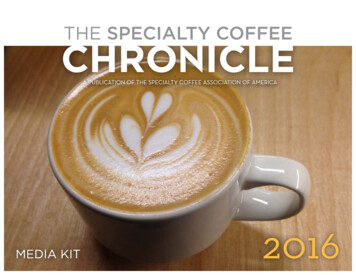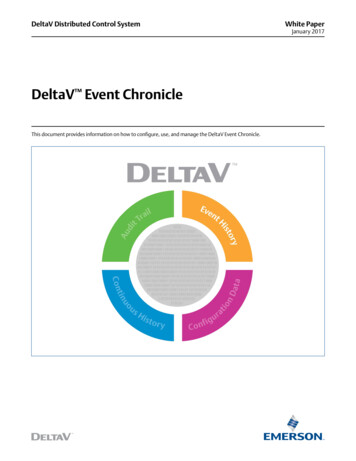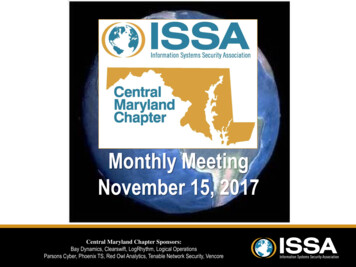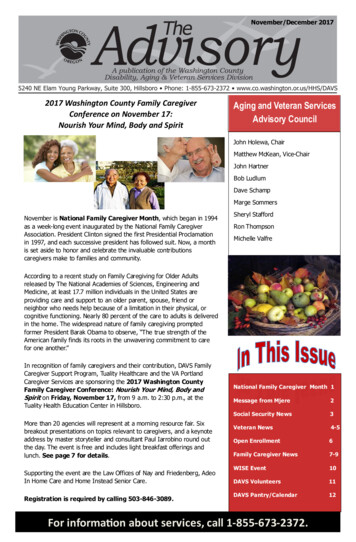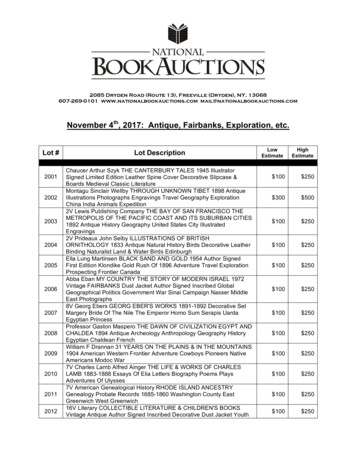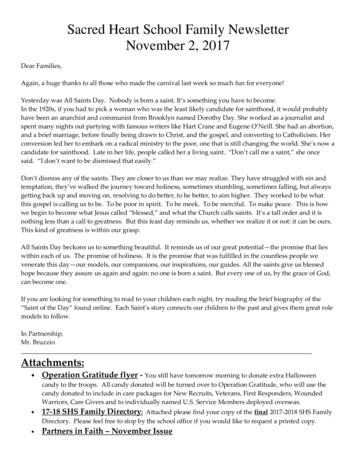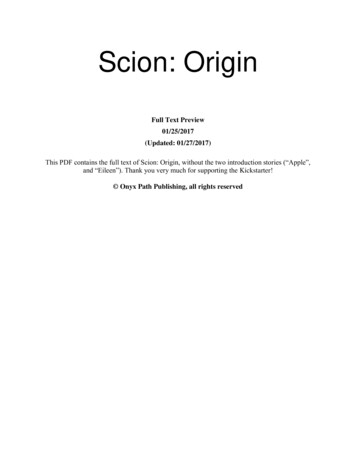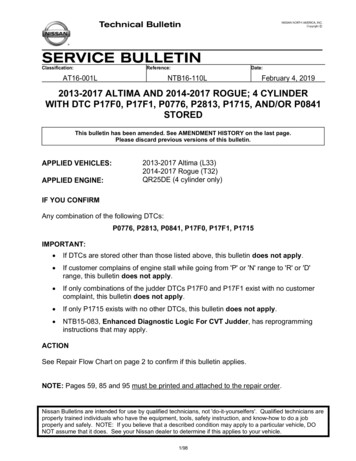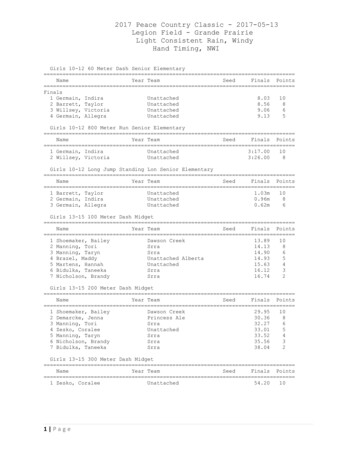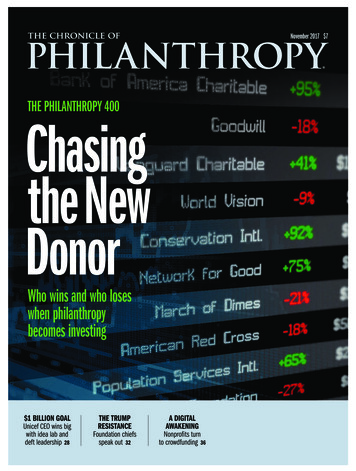
Transcription
the chronicle ofNovember 2017 7PHILANTHROPY THE PHILANTHROPY 400Chasingthe NewDonorWho wins and who loseswhen philanthropybecomes investing 1 BILLION GOALUnicef CEO wins bigwith idea lab anddeft leadership 28THE TRUMPRESISTANCEFoundation chiefsspeak out 32A DIGITALAWAKENINGNonprofits turnto crowdfunding 36
EVERY DONOR MATTERS.Develop and grow your most valuablerelationships for freeat donorperfect.com/Chron.MostAwardedFundraising System
THE CHRONICLE OFPHILANTHROPYVolume 30, Issue 1November 2017BRYAN KASMLEADINGTHE PHILANTHROPY 4008The Yearof the New DonorThe Chronicle’s latest ranking reveals trends that arechanging giving — including opposition to PresidentTrump. Also, see the 20 groups that raised the mostlast year.Forecast: Could charities close out the yearwith a fundraising bang? 18Trends: How key nonprofit causes are faring. 12Data: Charities with the biggest cash haul. 1628 Taking a PageFrom Silicon ValleyCaryl Stern is shaking things up at UnicefUSA — creating technology products,starting an innovation lab, doing marketresearch on donors, and doubling revenue.GRANT MAKING32 Look Who’sSpeaking OutFoundation leaders oncereluctant to join the publicfray are sounding off on racism, hate,and the president’s agenda.Analysis: Social-service groups aim to turn the tide. 20Case Studies: 3 charities make a mark with their skill inattracting big donations, small gifts, or donated goods. 22ON THE COVER: ILLUSTRATION FEATURES CHANGE IN GIVING TO THE ORGANIZATIONSFROM THE 2012 TO 2016 FISCAL YEARS.COMING IN DECEMBERFUNDRAISING36 Playing to the CrowdAmateur fundraisers have demonstratedthe power of Kickstarter and similarsites. Now colleges, museums, and othernonprofits are getting in on the action.The Influencers. Meet nonprofit movers and shakers who are quietly doingexciting things. They’re working under the radar but making a big impact.The Chronicle of Philanthropy (i.s.s.n. 1040-676x) is published monthly, 12 times a year by The Chronicle of Higher Education, Inc. at 1255 Twenty-Third Street, N.W., Washington, D.C. 20037. The Chronicle of Philanthropy is a registered trademarkof The Chronicle of Higher Education, Inc. Subscription rate: 84.00 per year. Periodicals postage paid in Washington, D.C., and at additional mailing offices. Registered for g.s.t. as The Chronicle of Higher Education Inc. g.s.t. No. R-129 572 830.Postmaster: Send address changes to The Chronicle of Philanthropy, P.O. Box 16359, North Hollywood, CA 91615. Member, Alliance for Audited Media.THE CHRONICLE OF PHILANTHROPYnovember 20173
“What are you going to stand for,and what are you going to fight for?” Page 35GIVING6 The Face of Philanthropy: Two foundations are supportinga Dutch nonprofit that trains rats to sniff out TB.WRITER’S NOTEBOOK: BEHIND THE STORYBefore interviewing Unicef USA chiefexecutive Caryl Stern for this month’s issue, I knew her as the nonprofit executivewho in 2012 exchanged Twitter barbswith Donald Trump before such salvosfrom the White House became routine.(Mr. Trump erroneously tweeted that Ms.Stern drove a Rolls-Royce — it’s a 2007Prius — and earned more than 1 million— twice her salary.)“We are not Democrat or Republican. The only side we’re on is the side ofa child. I’ll say that mantra 20 times if Ineed to,” Ms. Stern told me when I askedabout the impact of the 2016 election onher organization. She says an “educationprocess,” always required with new leaders in Washington, is underway.Deft navigation of difficult subjectsis characteristic of Ms. Stern, a brilliant communicator who has used herpersonal biography — the daughter of aJewish World War II refugee placed on aboat at the age of 6 — and the stories ofthe children she meets around the worldto raise half a billion dollars annually.Ms. Stern is also an assiduous, decades-long student of organizational54 On the Rise: The son of Pakistani immigrants aims tobuild the next generation of Muslim American donors.Page 28structure and management style, writingand teaching classes on the subject. Perhaps it helps explain how, at age 28, shewas made a university dean, one of manythings that leaps out in her long resume.As a child growing up in New York, Ms.Stern told me, she would occasionally askher mother how the Holocaust was possible. “She told me at the time that peoplewould say that they didn’t know what wasgoing on. Well, that is what’s happeningtoday, and we do know what’s going on,”Ms. Stern said of the refugee crisis.Her travel schedule takes her to refugee camps and rural villages ravagedby hunger and disease. Still, for all thesuffering she has witnessed, Ms. Sternsays, she has learned that children arechildren no matter what the setting.She recalled meeting with a group of12-year-old girls in a camp in Darfur.“I thought we were going to talk aboutthe horror they had seen before theycame to the camp, but they heard I had ason who was their age, and they wantedto talk about boys. That’s what 12-yearold girls want to talk about.”GO TO PHILANTHROPY.COMYear-End Fundraising Examples and IdeasNearly a quarter ofhousehold charitablegiving occurs betweenThanksgiving and NewYear’s. Get advice onhow to set your nonprofitapart from the pack.5 Ways to RaiseMoney When DonorsAre Consumed byNonstop NewsTips for winning attentionwhen your cause isn’t thetopic of the moment.49 Boards: How to find socioeconomically diverse trustees.50 Careers: 8 ways to nurture high-potential employees.53 People: New leaders at the Brookings Institution,Muscular Dystrophy Association, NAACP, Susan G.Komen, and more.FUNDRAISING52 Research: Why giving days may favor big-namecharities.OPINION— MEGAN O’NEILGet hundreds of resources and tools4 Ways to Win OverYear-End DonorsLEADINGWEBINARYear-End Campaigns:Strategies ThatWorkThis on-demand sessionoffers smart ideas tohelp you make the mostof the giving season.41 William F. Meehan IIIand Kim Starkey Jonker onthe steps nonprofits,foundations, boards, andeveryday donors musttake so that charities canserve the growing needsof society.44 Josh Wilson says foundations should focus moreof their journalism grants on serving the publicinterest and not so much helping the news industryfix its financial woes.46 Suzanne Garment and Leslie Lenkowsky on the dangersof nonprofits looking too self-interested in theirlobbying on tax-code changes.A GUIDE TO MANAGING NONPROFITS55 Information from companies and organizations thatprovide help with all aspects of leading nonprofits.LATEST RESOURCESnA checklist and sample contracts for more effective crowdfundingnHow to encourage reluctant leaders to ask for moneynnJeffersonian dinners: Engage new supporters andget beyond idle chitchat, pulling them deeper intothe mission and asking for their ideas — but nottheir moneyTo tap into corporate money, find employees tochampion your causeCORRECTIONSArticles on The Chronicle’s How America Gives study (October)misidentified Susan Raymond. She remains a consultant and generalcounsel with Changing Our World, and she is chief operating officer atEdmundite Missions Enterprises.nA piece on philanthropy in New Orleans (October) incorrectly saidthat about a third of the 4.9 million raised on the city’s May givingday came from gifts of 10. The “third” should have referred to thenumber of gifts, not the amount given.nAn article about Prudential’s grant making (October) said thecompany had set a goal for 2020 to invest 1 billion in impactinvestments instead of to build a 1 billion portfolio of impactinvestments.nn4Tips for running a crowdfunding drivenovember 2017THE CHRONICLE OF PHILANTHROPY
Gift Illustration Softwarein the Cloud CresPRO CresPro online softwaregives you unparalleled accessto the tools you need toengage with your donorsand close more giftsGift Programs - CresPro includes everythingyou need to illustrate and close plannedand blended gifts – from persuasive donorfriendly proposals to detailed technicalexplanations, trust documents and more30-Day Free Trial Access CresPro Anywhere - You can useCresPro in the office, on the road, your hotelroom and even on airplane Wi-FibookMagazine Quality Proposals - When CresProis paired with our GiftLegacy Pro marketingservice, you can customize donor proposalswith your logo, photos, colors, fonts and text Immediate Updates - Always have the mostcurrent gift information and software updateswhen meeting with donorsIntegrated Marketing for Planned GiftsDiscover the power of CresPro4For a free trial, visit cresgift.com/softwareCrescendo has become anintegral part of Baylor University’s giftplanning marketing program sincewe began our relationship in 2009.In the last five fiscal years, 2013-2017,Baylor has documented 226 newplanned gifts for approximately 139million and realized 162 estate distributions of over 54 million. Baylor appreciates and highly values thetools, services and support provided by Crescendo’sfriendly and professional staff.– Larry SmithAssistant VP, Gift Planning (Baylor University)
THE FACE OF PHILANTHROPYTraining Ratsto Sniff Out,and Snuff Out, TBFor years, rats trained by the Dutch nonprofit Apopo have sniffed out TNT-ladenlandmines, accelerating the slow, painstaking process of de-mining in countries likeMozambique and Cambodia.That work continues, but now the organizationis pointing its rats’ noses at another global healthproblem: tuberculosis. The African giant-pouchedrat, it turns out, can detect the infectious diseasemuch faster than humans can process samples.Apopo started its first rat TB-detection programin Dar es Salaam, Tanzania, in 2007. A single ratcan check 100 TB samples in 20 minutes. It wouldtake a lab technician using the traditional methodof a smear microscopy — which has an accuracyrate of 20 to 60 percent — four days to get throughthat many samples. Research studies show ratscan identify TB samples accurately more than 60percent of the time, and often at rates much higher. The nonprofit says it has been able to increasethe detection rates at partner clinics by more than40 percent.Each year there are about 10.8 million new cases of TB globally, and 1.8 million people die fromthe disease.Because the rats work so fast, they’re especiallyvaluable in densely populated areas, like big citiesand prisons, says Charlie Richter, Apopo’s U.S.director.With its rats already at work on TB in Tanzaniaand Mozambique, Apopo is now deploying themin Ethiopia with money from the Skoll and EltonJohn AIDS foundations.Individual donors can adopt a rat and followthe animal’s work online starting at 7 a month.Apopo will soon offer larger sponsorship opportunities for foundations and companies, which willallow supporters to do things like name a rat aftertheir CEO.Here, a rat named Chewa screens samples forTB with his trainer Sezirahiga David Dario in anApopo lab in Dar es Salaam.— MEGAN O’NEIL6november 2017THE CHRONICLE OF PHILANTHROPY
BRIANA FORGIETHE CHRONICLE OF PHILANTHROPYnovember 20177
TOP 20Fidelity Charitable1 Gift FundGroups that raised the most in 2016(and the percentage change over 2015) 4.1 billion (-12%)23United WayWorldwide 3.5 billion (-5%)4Goldman SachsPhilanthropy Fund 3.2 billion (450%)5Task Force forGlobal Health 3.2 billion (92%)FeedingAmerica 2.4 billion (11%)THE PHILANTHROPY 400Capturingthe New DonorCharity supporters increasingly see their giftsas investments in change — and back nonprofitsthat promise solid returns.By HEATHER JOSLYN and PETER OLSEN-PHILLIPSWith the bulls running wild on Wall Street,charities that appeal to a new breed of investment-minded donors saw big gains in 2016,according to the Philanthropy 400, The Chronicle’s annual ranking of charities based on thesupport they raise from individuals, foundations, andcorporations.As a group, these 400 nonprofits raised a total of 108.7 billion — more than a quarter of all dollarsgiven to American charities in 2016. Donations wereup 5 percent among groups that appeared on both lastyear’s rankings and this year’s. Those numbers containcompelling stories about how philanthropy is changing,along with donors.The new donors take many forms. They are affluentAmericans pouring assets into donor-advised funds118HarvardUniversity 1.2 billion (14%)november 201712ALSAC/St. Jude Children’sResearch Hospital 1.1 billion (10%)13at a furious pace, forgoing the family foundationsthey might have created only a few years ago. They arestock-market winners looking for charities sophisticatedenough to handle gifts of appreciated equities.Many new donors are new to charitable giving altogether. They are policy-minded progressives shaken bythe election of President Trump and showering moneyon organizations that aim to protect civil liberties, immigrants, women’s health, and even information itself.The new donors are tech-savvy and impatient. Theyaren’t satisfied to slap Band-Aids on social problems butwant to rebuild entire systems: education, health care,criminal justice. They’re drawn to charities that frametheir appeals for support as “investments.”Look no further than the top of the ranking to seeContinued on Page 10The Y 1.0 billion(-13%)14NationalPhilanthropic Trust 1.0 billion (11%)15Food forthe Poor 988 million (-15%)THE CHRONICLE OF PHILANTHROPY
6SchwabCharitable Fund 1.9 billion (-9%)16StanfordUniversity 951 million (-41%)7SalvationArmy 1.9 billion (-1%)17THE CHRONICLE OF PHILANTHROPY8Habitat forHumanity International 950 million (12%)National ChristianFoundation 1.5 billion (6%)18AmericaresFoundation9 914 million (24%)Silicon ValleyCommunity Foundation 1.4 billion (12%)1910Boys & GirlsClubs of America 869 million (-6%)Vanguard CharitableEndowment Program 1.3 billion (6%)20CatholicCharities USA 832 million (2%)november 20179
THE PHILANTHROPY 400No. 65Catholic MedicalMission Board1-year change 31%The Big PictureBig nonprofits are outpacing other groups:Even as contributions to the Philanthropy400 rose 5 percent in 2016, growth was flatfor charities over all, according to “GivingUSA,” at only 1.4 percent.Giving remains highly concentrated with thelargest charities: Giving to the Philanthropy400 accounted for 28 percent of all dollarsgiven to charity in 2016, roughly the same asin recent years.Giving is good at the top: The top 10 groupscollectively raised 3 billion more this yearthan last — a 13 percent increase. They nowaccount for 22 percent of all giving to thePhilanthropy 400.A Zambian child undergoes a health assessment by a worker for Catholic Medical Mission Board.Continued from Page 8the new donors in action. Fidelity CharitableGift Fund claimed the No. 1 spot for the second straight year, despite a nearly 12 percentdrop in support in 2016. At 4 billion raised, thedonor-advised-fund manager was still a half-billion dollars ahead of its nearest rival, UnitedWay Worldwide.In 2017, uncertainty — the buzzword of 2016— remains a factor. Donors don’t know whatcharitable deductions will be available if theTrump administration and Congress rework thetax code. And fundraisers wonder if gifts madein response to this year’s wildfires and string ofhurricanes will replace year-end contributionsthey count on.Read on for more takeaways from the latestPhilanthropy 400:Donor-advised funds continueto dominate.While giving to Fidelity Charitablewas off in 2016, it is roaring back in2017. When Fidelity’s fiscal year ended June 30, it had raised nearly 6.9billion. That’s up 68 percent from the 4 billion it collected in fiscal 2016.The dominance of donor-advised fundsextends far down the Philanthropy 400. Six organizations in the top 10 are primarily built on thefunds, which are accounts in which individualsdonate assets, receive a tax benefit, and can laterpick the charities that will receive the money. Thetop 10 groups account for 22 percent of all dollarscontributed to Philanthropy 400 organizations.10november 2017One thing fueling the trend, other than therobust stock market: More wealthy people areshuttering family foundations and pouring theassets into donor-advised funds. Or they arebypassing the expense and hassle of foundationsaltogether.At Vanguard Charitable Endowment Program (No. 10, up 6 percent in 2016), transfers ofall or portions of a private foundation’s assets toVanguard donor-advised funds increased by 34percent last year, according to Jane Greenfield, theorganization’s president. Some donors make thatshift to donor-advised funds, she says, becausetheir children don’t want their philanthropy to belocked into the mission of a private foundation.Instead, the younger donors want to tailor theirgiving to their own priorities.“On the higher end of the business, we’re seeing some big movement there,” Ms. Greenfieldsays. “They’re finding that the next generationmight not have the same passion for that mission.”The Oregon Community Foundation (No. 108),grew nearly 237 percent, to 255 million, in 2016,thanks to one megagift (the transfer of real-estateholdings from donor Joseph Westin to his supporting foundation) but also the creation of manynew funds. These often represent a family’s ordonor’s first foray into serious philanthropy, saysMax Williams, the Oregon foundation’s leader. In2016, funds created to provide scholarships spikedby about a third compared with 2015, a development Mr. Williams attributes to skyrocketingcollege-tuition costs.The current year also looks bright, he says. Inan average year, the foundation raises between 75 million and 100 million. But with the stockTHE CHRONICLE OF PHILANTHROPY
The new donor expects sophistication.CATHOLIC MEDICAL MISSION BOARDmarket going gangbusters, more than 100 millionhad poured into the foundation’s coffers by theend of August.To many in the nonprofit world, donor-advised funds represent an unwelcome change tocharitable giving. Critics say they amount to awarehousing of philanthropic capital that couldbe put to better use if distributed to worthycauses more immediately. Organizations managing funds are often more opaque than eventhe most guarded private foundation; asidefrom a few crumbs of information they leaveon tax returns, they have no legal obligation toreport how money comes to them or how theypay it out.Case in point: Goldman Sachs PhilanthropyFund, which this year pushed its way to No. 3 onThe Chronicle’s list, with a staggering 450 percentincrease in support from 2015, the biggest gainin the survey. Though the fund is now one of thelargest charities in America, officials declined interview requests to discuss its 2016 gain with TheChronicle. In an emailed statement, a spokesmancredited the increase to the fund’s “philanthropic-minded families.”At least some in the nonprofit industry see thegrowth of donor-advised funds positively. PeterFissinger, president of Campbell & Company,a fundraising consulting firm, is sympatheticto concerns that some people may simply parktheir money in a donor-advised fund. But he’s notworried.“I think any one thing that helps institutionalize philanthropy is good,” Mr. Fissinger says.Besides, he adds, “studies show that most people,when they have that money sittin’ there, startthinking about where to give it.”THE CHRONICLE OF PHILANTHROPYDonors are getting more discerning about how they want to give. Tokeep up with them, fundraisers saythey’re learning how to structurecomplex gifts — and introduce thoseideas to supporters.Aly Sterling, president of a fundraising consulting company based in Toledo, Ohio, saysone creative means of giving is the “hybrid” gift.This might be a cash contribution for a charity’scurrent needs coupled with a life-insurance policythat names the organization as a beneficiary, forfuture giving. “We’re seeing a ton of those hybridgifts now, even from younger donors,” Ms. Sterlingsays.Tulane University (No. 286) was up nearly 12percent, to 99 million, in fiscal 2016. It had aneven better fiscal 2017, which ended in June andtotaled 126 million. The New Orleans university,which had to rebui
Unicef CEO wins big with idea lab and deft leadership 28 THE TRUMP RESISTANCE Foundation chiefs speak out 32 A DIGITAL AWAKENING Nonprofits turn to crowdfunding 36 Chasing the New Donor Who win
